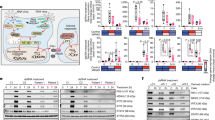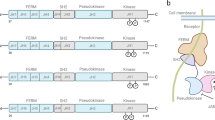Abstract
Bax (Bcl2-associated X protein) is an apoptosis-inducing protein that participates in cell death during normal development and in various diseases1. Bax resides in an inactive state in the cytosol of many cells. In response to death stimuli, Bax protein undergoes conformational changes that expose membrane-targeting domains, resulting in its translocation to mitochondrial membranes, where Bax inserts and causes release of cytochrome c and other apoptogenic proteins2. It is unknown what controls conversion of Bax from the inactive to active conformation. Here we show that Bax interacts with humanin (HN), an anti-apoptotic peptide of 24 amino acids encoded in mammalian genomes3,4. HN prevents the translocation of Bax from cytosol to mitochondria. Conversely, reducing HN expression by small interfering RNAs sensitizes cells to Bax and increases Bax translocation to membranes. HN peptides also block Bax association with isolated mitochondria, and suppress cytochrome c release in vitro. Notably, the mitochondrial genome contains an identical open reading frame, and the mitochondrial version of HN can also bind and suppress Bax. We speculate therefore that HN arose from mitochondria and transferred to the nuclear genome, providing a mechanism for protecting these organelles from Bax.
This is a preview of subscription content, access via your institution
Access options
Subscribe to this journal
Receive 51 print issues and online access
$199.00 per year
only $3.90 per issue
Buy this article
- Purchase on Springer Link
- Instant access to full article PDF
Prices may be subject to local taxes which are calculated during checkout




Similar content being viewed by others
References
Ranger, A. M., Malynn, B. A. & Korsmeyer, S. J. Mouse models of cell death. Nature Genet. 28, 113–118 (2001)
Wolter, K. G. et al. Movement of bax from the cytosol to mitochondria during apoptosis. J. Cell Biol. 139, 1281–1292 (1997)
Hashimoto, Y. et al. A rescue factor abolishing neuronal cell death by a wide spectrum of familial Alzheimer's disease genes and Aß. Proc. Natl Acad. Sci. USA 98, 6336–6341 (2001)
Hashimoto, Y. et al. Detailed characterization of neuroprotection by a rescue factor humanin against various Alzheimer's disease-relevant insults. J. Neurosci. 21, 9235–9245 (2001)
Nechushtan, A., Smith, C., Hsu, Y.-T. & Youle, R. Conformation of the Bax C-terminus regulates subcellular location and cell death. EMBO J. 18, 2330–2341 (1999)
Fesik, S. W. Insights into programmed cell death through structural biology. Cell 103, 273–282 (2000)
Tajima, H. et al. Evidence for in vivo production of Humanin peptide, a neuroprotective factor against Alzheimer's disease-related insults. Neurosci. Lett. 324, 227–231 (2002)
Suzuki, M., Youle, R. J. & Tjandra, N. Structure of bax: Coregulation of dimer formation and intracellular localization. Cell 103, 645–654 (2000)
Jin, C. & Reed, J. C. Yeast and apoptosis. Nature. Rev. Mol. Cell Biol. 3, 453–459 (2002)
Xu, Q., Ke, N., Matsuyama, S. & Reed, J. C. in Methods in Enzymology (ed. Reed, J. C.) 283–296 (Academic, San Diego, 2000)
Wei, M. C. et al. Proapoptotic BAX and BAK: a requisite gateway to mitochondrial dysfunction and death. Science 292, 727–730 (2001)
Kermer, P. et al. BAG1 is a regulator and marker of neuronal differentiation. Cell Death Differ. 9, 405–413 (2002)
Elbashir, S. M. et al. Duplexes of 21-nucleotide RNAs mediate RNA interference in cultured mammalian cells. Nature 411, 494–498 (2001)
Zhang, L., Yu, J., Park, B. H., Kinzler, K. W. & Vogelstein, B. Role of BAX in the apoptotic response to anticancer agents. Science 290, 989–992 (2000)
Nouraini, S., Six, E., Matsuyama, S., Krajewski, S. & Reed, J. C. The putative pore forming-domain of bax regulates mitochondrial localization and interaction with bcl-XL . Mol. Cell Biol. 20, 1604–1615 (2000)
Zelphati, O. et al. Intracellular delivery of proteins with a new lipid-mediated delivery system. J. Biol. Chem. 276, 35103–35110 (2001)
Jurgensmeier, J. M. et al. Bax directly induces release of cytochrome c from isolated mitochondria. Proc. Natl Acad. Sci. USA 95, 4997–5002 (1998)
Stryer, L. Biochemistry (Fredman, New York, 1988)
Gray, M. W., Burger, G. & Lang, B. F. The origin and early evolution of mitochondria. Genome Biol. Rev. 2, 10–18 (2001)
Schendel, S., Montal, M. & Reed, J. C. Bcl-2 family proteins as ion-channels. Cell Death Differ. 5, 372–380 (1998)
Stroud, R. M., Reiling, K., Wiener, M. & Freymann, D. Ion-channel-forming colicins. Curr. Opin. Struct. Biol. 8, 525–533 (1998)
Guo, B., Godzik, A. & Reed, J. C. Bcl-G, a novel pro-apoptotic member of the Bcl-2 family. J. Biol. Chem. 276, 2780–2785 (2001)
Atherton, E. & Sheppard, R. C. Solid-phase Synthesis (Oxford Publishing, New York, 1989)
Acknowledgements
We wish to thank the NIH and the Department of Defense for its generous support. We also thank R. Cornell and A. Sawyer for manuscript preparation, and B. Vogelstein, D. Bredesen, R. Youle and I. Nishimoto for reagents.
Author information
Authors and Affiliations
Corresponding author
Ethics declarations
Competing interests
The authors declare that they have no competing financial interests.
Rights and permissions
About this article
Cite this article
Guo, B., Zhai, D., Cabezas, E. et al. Humanin peptide suppresses apoptosis by interfering with Bax activation. Nature 423, 456–461 (2003). https://doi.org/10.1038/nature01627
Received:
Accepted:
Published:
Issue Date:
DOI: https://doi.org/10.1038/nature01627
This article is cited by
-
Single-Cell Transcriptional Profiling and Gene Regulatory Network Modeling in Tg2576 Mice Reveal Gender-Dependent Molecular Features Preceding Alzheimer-Like Pathologies
Molecular Neurobiology (2024)
-
Mitochondria-derived peptide MOTS-c: effects and mechanisms related to stress, metabolism and aging
Journal of Translational Medicine (2023)
-
Evidence of natural selection in the mitochondrial-derived peptides humanin and SHLP6
Scientific Reports (2023)
-
Effects of intracerebroventricular MOTS-c infusion on thyroid hormones and uncoupling proteins
Biologia Futura (2023)
-
Single-cell transcriptomics of human iPSC differentiation dynamics reveal a core molecular network of Parkinson’s disease
Communications Biology (2022)
Comments
By submitting a comment you agree to abide by our Terms and Community Guidelines. If you find something abusive or that does not comply with our terms or guidelines please flag it as inappropriate.



